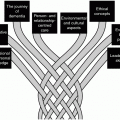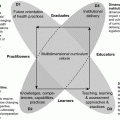- Dementia
Dementia is now referred to as a neurocognitive disorder (NCD) (American Psychiatric Association, 2013), that is, the result of chronic or progressive damage to the brain.
Early signs of dementia
Mary, aged 76, lives alone. Her husband died shortly after he retired some 10 years ago and the couple had no children. Mary used to work in an office, but has lost touch with most of her former workmates now. Her one companion is a much loved dog named Freddie, although there is also a niece who visits from time to time. She has been a patient of her GP for over 10 years. She books a regular monthly appointment for a blood pressure check, repeats of her eight medications when necessary and a bit of a chat. She has quite stable diabetes, for which she is taking oral medication, and every three months she has this reviewed under a chronic disease management plan. She has never brought along her niece to these appointments.
The GP asks Mary to book a routine annual 75+ Health Assessment to be conducted by the practice nurse. During this assessment, the practice nurse asks Mary if she ever has any problems with her memory. When Mary responds in the affirmative, the nurse administers the standardized Mini-Mental State Examination (MMSE), which is a brief test of cognitive function (Molloy & Stamdish, 1997). It is scored out of 30 and the cut off is usually 23/24 (i.e. if the person scores 23 or below they are thought to be in need of further assessment for dementia). Mary scores 24. Despite this being in the normal range, the nurse is a bit concerned as she scored 28 in the previous year. The nurse knows Mary quite well, from assisting with her diabetes checks, and feels that Mary is ‘not herself’, because she seems a bit anxious and more disorganised than usual. She asks Mary for permission to talk to her GP about the interview as well as giving him the health assessment.
To assist you, see Chapter 1, especially ethical principles, collaborative practice, communication; Chapter 2 on diagnosis of dementia; and Chapter 9 on ethics, especially Figure 9.1, p. 152, on Ethics First Aid © checklist.
When Mary goes back to see the GP, he questions her about her memory and also how well she is performing in her usual activities of daily living. She agrees that her memory is not what it was but states that she is managing well at home. ‘I don’t want to go into a home,’ she says tearfully. ‘What would I do with Freddie?’
At this point, the GP wonders if Mary might be affected by depression. He asks her the questions on the Geriatric Depression Scale (GDS) (Yesavage et al., 1983) and finds that she scores in the depression range on this. Depression might well account for her poor cognition. She readily agrees that she might be depressed and goes along with a plan to see a psychologist who visits the practice each week. However, she doesn’t think it will do much good. ‘I’m lonely,’ she says. ‘I don’t know what I would do without Freddie.’
See Chapter 2 on making the diagnosis of dementia.
To assist you, see Chapters 1 and 8 on person- and relationship-centred care, and Chapter 3 on collaborative practice.
Several weeks later, the GP receives a report from the psychologist, whose own testing has found Mary to be both depressed and anxious. She states that Mary is responding well to some simple breathing exercises and positive events scheduling suggested as treatment, and still has a number of treatment sessions to go.
The GP decides to conduct a case conference about Mary with the psychologist and the practice nurse. The case conference is run in the surgery, with the psychologist on the phone and both the GP and the practice nurse attending. Each professional contributes their thoughts about Mary and it is decided that the practice nurse should explore socialisation options with her, to reduce her loneliness. This can easily be done with funding through the practice nurse Medicare item numbers associated with Mary’s chronic disease management plan.
When the nurse meets Mary, they run through a number of options, and in the end Mary agrees to join the knitting group that meets weekly in the library, and also visit the community health centre lunch program once a month. The nurse organises attendance to the lunch program over the phone, and gives Mary details about the knitting group. (Note: the ‘local context’ in Figure 3.3. Different geographical locations will have different activities available.)
At the case conference, the practice nurse had expressed some concerns about Mary managing her medications. As a result, the GP also organises a pharmacy home medications review. This review explores whether Mary understands and manages her medications correctly, looks at the options for reducing the number of medications with available combination tablets and explores whether any of them might be contributing to Mary’s forgetfulness. The number of medications is reduced from eight to six daily as a result, and Mary is issued with a Webster-pak, in which the medications are packed in easily accessible doses for each day.
To assist you, see the Chapter 3 section on collaborative practice, Chapter 4 on evidence-based practice and Chapter 5 on leadership.
- Leadership
Leadership is a process of social influences that maximise the efforts of others towards the achievement of a goal.
Three months’ later, the GP asks the nurse to review Mary and complete another MMSE and GDS. Both have improved and are now well within the normal range. Nevertheless, the GP decides to keep a close watch on Mary. He knows that depression in the elderly is often a precursor to dementia.
Middle stage of the dementia journey
The following year, the practice nurse again runs through the 75+ Health Assessment with Mary. As in the previous year, Mary complains that her memory is ‘not what it used to be’, so the nurse again administers the MMSE. This time Mary scores 21 out of 30. The nurse also runs through the GDS and Mary scores within the normal range. The nurse asks Mary a series of questions about her ability to perform activities of daily living. Mary states that she is coping well but the nurse senses again that things are not as they should be. Mary appears a bit dishevelled and was late for her appointment. She has also lost 5kg in weight compared with her assessment last year. The nurse thinks that it would be ideal if she could talk to another family member who knows Mary well, to find out what is really going on. She suggests this to the GP.
This time, when Mary goes to the GP for her health assessment review she brings her niece, Alison, with her, as requested. The GP explains that the practice is concerned because some of the memory tests are not as good as they were and also because Mary has lost weight. He asks Alison what she thinks about the situation.
Stay updated, free articles. Join our Telegram channel

Full access? Get Clinical Tree






